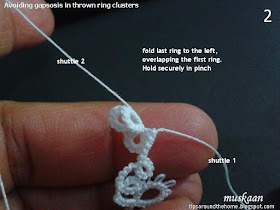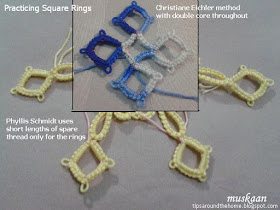free vintage edging pattern in modern notation
this post is in a lighter vein, though it involved serious work
-- muskaan,
May 31, 2017
This is an image from the original Georgia sent me, for working out the sequence and diagramming. Here all 5 rows were tatted separately, with tie and cut after each.
During my first revisit of the tatted edging from Coats andClark (Book 121, Pattern 295), without specific guidelines, I didn’t want to change anything, except climbing out of rows for a continuous tat. Hence rows I to IV were tatted as one continuous unit. Then tie and cut. And row V was worked separately.
I know you must be bored, but hey, “I’m picky” ;-P And hopefully no hieroglyphic this time!
I will be striking out all previous pdfs to avoid confusion in future.
Thank you Georgia and the Online Tatting Class
this post is in a lighter vein, though it involved serious work
Hieroglyphic,
err, Arsenic and Old Lace
dedicated to the wonderful Online Tatting Class
A mummy wrapped in old
lace,
I sought to make new and
replace
with minimal invasion –
a diagram and notation.
There arose a cry in class
‘how to tat this is one
pass?’
To a new diagram it led,
but wasn’t clearly read.
The new sequence
highlighted,
Why was not it sighted ?
Was there a real glitch
or words were like
hieroglyphs ?
Such tricks plays our
brain
This is arsenic, pain not
again !
The new mummy they turned
over
To decipher the top as
the lower !
I promise, je promets, lo prometto – the last and final
revision of this edging. And I do apologise for putting my dear readers through this
yet again - March, April, and now May, oops - the mummy rises again !
This is an image from the original Georgia sent me, for working out the sequence and diagramming. Here all 5 rows were tatted separately, with tie and cut after each.
During my first revisit of the tatted edging from Coats and
Some tatters wondered how to make all 5 rows in one go.
Hence I included this in a revised diagram (below), to be read in
conjunction with the original modern notation, and all links and information were
provided in that single page (shown encircled)
Yet confusion persisted. Eyes went straight for the
diagram, skipping the written matter which was highlighted through colour coding, or within
boxes and the tatting sequence was the first thing on the page ! They were Not
hieroglyphs, were they ?!
I recently finished reading The Brain by David Eagleman and it is an 'eye'-opener to see how our brain takes over all our perceptions, sensations, knowledge, learning, comprehension, actions and reactions.
I recently finished reading The Brain by David Eagleman and it is an 'eye'-opener to see how our brain takes over all our perceptions, sensations, knowledge, learning, comprehension, actions and reactions.
Anyway, they solved it by turning the page upside down ;-D (Ingenious lot here, though momentarily
blinded by the diagram perhaps, ;-P !)
Why ? Because then Row I became oriented correctly – the
way we would tat it. Another TWoT lesson for diagrammers.
All this could’ve have easily avoided if I hadn’t tried to avoid some extra work (yeah, yeah, a stitch in time …. and all that jazz ;-P) I should’ve re-oriented the pattern (in pic below) for the revised diagram, but thought it’d be too much work. It is easy enough to flip a diagram in Inkscape; turns out it is just as easy to flip the numbers – individually or as a group !!! I did have to reposition, but it was all fairly quick work. Another happy lesson learned too late :-)
All this could’ve have easily avoided if I hadn’t tried to avoid some extra work (yeah, yeah, a stitch in time …. and all that jazz ;-P) I should’ve re-oriented the pattern (in pic below) for the revised diagram, but thought it’d be too much work. It is easy enough to flip a diagram in Inkscape; turns out it is just as easy to flip the numbers – individually or as a group !!! I did have to reposition, but it was all fairly quick work. Another happy lesson learned too late :-)
So I give you yet again, the re-revised reoriented and this time
stand-alone pattern for the edging. download reoriented diagram-only pdf here.
Since I was going through it all again, and I didn't want to show you the same old pic, I tatted another sampler, this time in black size 50.
And I also made another pdf this time with the pattern in written notation too.
download Complete reoriented pattern pdf with diagram and text here
Since I was going through it all again, and I didn't want to show you the same old pic, I tatted another sampler, this time in black size 50.
And I also made another pdf this time with the pattern in written notation too.
download Complete reoriented pattern pdf with diagram and text here
I know you must be bored, but hey, “I’m picky” ;-P And hopefully no hieroglyphic this time!
I will be striking out all previous pdfs to avoid confusion in future.
Thank you Georgia and the Online Tatting Class
for new perspectives,
and for making me work harder to improve J
and for making me work harder to improve J
keep tatting till posterity J







































